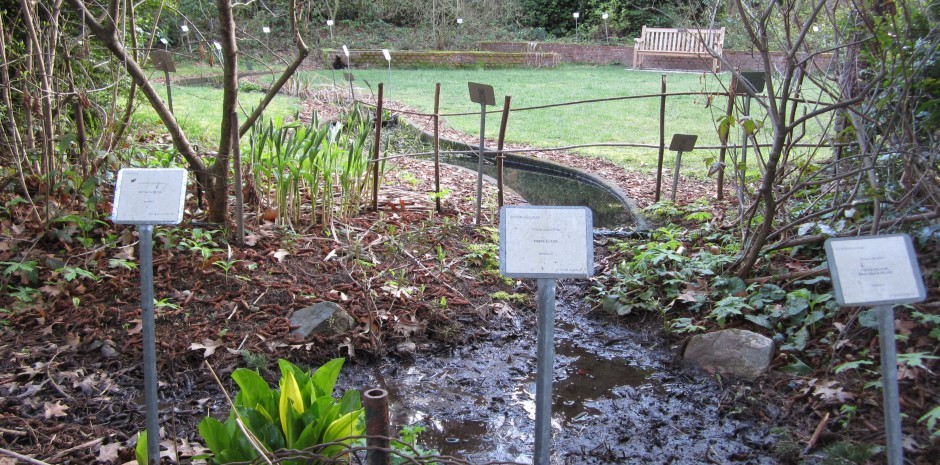What can I add, really? Here’s some of what is currently flowering (or interesting) in the Medicinal Herb Garden. Not bad for April.

Geranium maculatum (wild geranium) section E. Prized by Native Americans for its astringent properties, it has been used to treat diarrhea, hemorrhoids and other conditions.

Convallaria majalis (lily of the valley) section E. Milder in its effects than Digitalis, it has been used for centuries to treat heart conditions.

Aronia melanocarpa (black chokeberry) sunny border areas. From eastern North America, this shrub produces black fruit that many consider to be a superfood.

Camassia quamash (camas) section B. The bulbs of these beautiful plants are edible and were collected and cultivated by Native Americans.

Rosa nutkana (nootka rose) Cascara Circle. It smells as sweet as it looks. This is a good native rose for a fairly sunny spot, if you don’t mind that it spreads and can get 10 feet tall. It should be more widely planted in Seattle.

Rehmannia glutinosa (di huang) section B. Also known as Chinese foxglove, it is used in Traditional Chinese Medicine to treat anemia, diabetes and other conditions.

Cochlearia officinalis (scurvy grass) section A. Not bad, but there are slightly better things to eat if you’re fighting scurvy.

Aquilegia canadensis (wild columbine) sections C and A. Eat your lunch by the wild columbine and you just might see a feeding hummingbird.

Luetkea pectinata (partridgefoot) section C. I collected the seeds to grow this plant on a long and memorable backpacking trip near Glacier Peak in the Cascade Mountains.

Bletilla striata (bai ji) sections E and F. Used in Traditional Chinese Medicine to reduce swelling and stop bleeding.

Linum perenne (perennial flax) section C. Though the flax seeds for commerce come from the annual Linum usitatissimum and can be eaten raw, this perennial species produces similar seeds which are toxic when raw but edible and nutritious after toasting.

Lomatium californicum (California lomatium) section C. Not all species of Lomatium have foliage that tastes good but the leaves of L. californicum taste like lovage (Levisticum officinale)

Sisyrinchium bellum (western blue-eyed grass) section D. It’s not in the grass family (Poaceae), but the iris family (Iridaceae). Still, common names are lovely. The foliage does resemble grass.

Prosartes smithii (Smith’s fairybells) section E. Speaking of common names…. Admit it, if you were a fairy, hovering around the Medicinal Herb Garden, you would feel the irresistible urge to ring a Smith’s or Hooker’s fairybell.

Arisaema triphyllum (Jack in the pulpit) section E. When they flower, you’ll see where they get their common name.

Asparagus cochinchinensis (tian men dong) section E. Snaky, spiky asparagus used in Traditional Chinese Medicine.

Phoenicaulis cheiranthoides (wallflower phoenicaulis) This was taken in eastern Washington, where they flower before ours in section D

Actaea rubra (red baneberry) section B. From seeds collected along the Upper Big Quilcene River on an east slope of the Olympic Mountains.

Anthriscus cerefolium (chervil) section F. A friend used to put a sprig of chervil, a slice of wild strawberry, and a pinch of powdered sugar on top of sweet cornbread muffins. Mmmmm.

Bunium bulbocastanum (earth chestnut) section A. The tubers are best in early fall. They taste like a cross between raw potato and coconut… in a good way.

Smilacina racemosa (false Solomon’s seal) flowers opening. If only you could smell this, you would swoon.
nootka rose, fringecups
columbine and fairy bells
nodding in the breeze
See you in the garden.












How do you use Taenidia integerrima? I love the smell of the leaves and would love to use it in my cooking somehow, but I am wary of plants in the Apiaceae that do not have a lot of information available about them. I’ve seen references to the roots being used by Native Americans to flavor food and references to the leaves being smoked by Native Americans, but I would love to hear someone’s experience who has actually used this plant.
Thank you!
Doug
Hi Doug,
Here’s a link to Daniel Moerman’s wonderful book, Native American Ethnobotany. If you enter Taenidia, several references to Native American uses appear. Unfortunately, though I put it in the garden, I have no experience using this plant.
http://herb.umd.umich.edu/
Good luck,
Keith